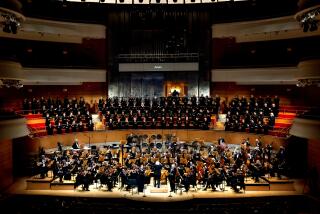MUSIC REVIEW : Organist Catherine Crozier Celebrates 80th With Recital
GARDEN GROVE â As some restaurants should be saved only for special events, some concert venues should be used only for musical marathons, anniversaries or other gala occasions.
The Crystal Cathedral, home of that huge, 12-year-old amalgam of two mammoth instruments--a Ruffatti and a Skinner, an organ standing five stories tall and incorporating 13,000 pipes, five manuals and 223 ranks--is such a venue.
The massive instrument was utilized appropriately Tuesday night, however, when Catharine Crozier, the veteran American organist who turned 80 last Friday, shared her birthday recital with a large audience of well-wishers, a few of whom no doubt came to see if Crozier still retains her fabled technique and probing musicality.
Not to worry. The beloved organist--looking slender but not frail, approaching the instrument with a purposeful walk and revealing its complex resources with unfailing insight--still offers musical integrity and virtuosic elan as the foundation of her recital performances. With Crozier, now as always, it seems, satisfaction can be guaranteed.
Her anniversary recital--she had also given comparable concerts at the Garden Grove church noting her 70th and 75th birthdays--took no easy course.
It began with three organ chorales of Bach, crested on a suite of excerpts from Nicolas de Grignyâs âMass for Organ,â revived for our delectation Jehan Alainâs brief and haunting Second Fantasy and ascended the several breathtaking climaxes of contrasting virtuoso pieces by Leo Sowerby: the late Fantasy for Flute Stops, âRequiescat in Paceâ (1920) and the Toccata (1940).
All these works Crozier delivered with sense and affection. Having conquered their various and pesky demands long since, she could concentrate on communicating their messages and structures. The results were, not surprisingly, engrossing and instructive: The music, piece by piece, sounded as important as it is, revealed its beauties without strain, and left one wanting more.
At the end, two encores had to suffice. First, a Postlude by Alain, then the Toccata from the Fifth Symphony by Widor.
More to Read
The biggest entertainment stories
Get our big stories about Hollywood, film, television, music, arts, culture and more right in your inbox as soon as they publish.
You may occasionally receive promotional content from the Los Angeles Times.










